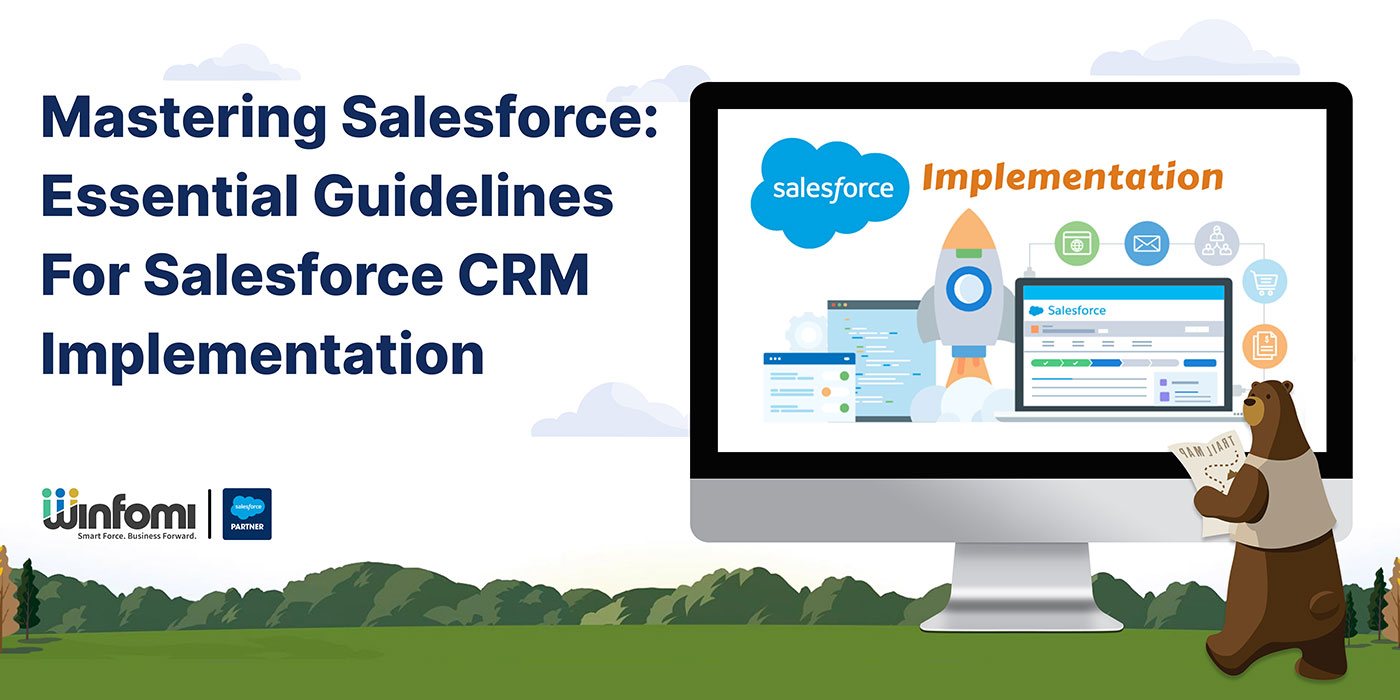

Share:
Table Of Contents
- Mastering Salesforce: Essential Guidelines For Salesforce CRM Implementation
- Defining CRM Implementation and its Importance
- Overview of Salesforce and its Role in CRM
- Key Considerations before Implementing Salesforce
- Aligning Business Goals with CRM Objectives
- Assessing and Streamlining Existing Processes
- Securing Executive Buy-In and Stakeholder Involvement
- The Do of Salesforce CRM Implementation
Mastering Salesforce: Essential Guidelines For Salesforce CRM Implementation

In the dynamic landscape of modern business, fostering meaningful customer relationships is not just a strategy but a necessity. This imperative has given rise to Customer Relationship Management (CRM) systems, and at the forefront of this revolution stands Salesforce. In this blog, we embark on a journey to master the art of Salesforce CRM implementation, understanding its importance, exploring key considerations, and unveiling the do and dont that can shape the success of your CRM strategy.
Defining CRM Implementation and its Importance
CRM implementation refers to the process of integrating a customer relationship management (CRM) system into an organizations daily operations. It involves the adoption and utilization of a CRM platform, such as Salesforce, to streamline and enhance customer interactions, sales processes, and overall business efficiency. Implementing CRM is crucial for businesses as it enables them to better understand and manage customer relationships, boost sales productivity, and improve customer satisfaction and loyalty.
Overview of Salesforce and its Role in CRM
Salesforce is a widely recognized and powerful CRM platform used by businesses of all sizes and industries. It offers a comprehensive suite of cloud-based applications, allowing organizations to manage various aspects of their customer relationships, sales, and marketing efforts in one centralized system. Salesforce provides a range of features and tools, including contact management, lead tracking, opportunity management, analytics, and collaboration, enabling businesses to streamline processes, increase productivity, and drive revenue growth.
Key Considerations before Implementing Salesforce
Before diving into Salesforce integration, there are several crucial considerations that organizations need to address to ensure a Successful CRM implementation.
Aligning Business Goals with CRM Objectives
The first step in Salesforce CRM implementation is aligning the overall business goals and objectives with the specific CRM objectives. Organizations should have a clear understanding of what they aim to achieve through the implementation, whether its increasing sales, improving customer service, or streamlining internal processes. By aligning CRM objectives with broader business goals, organizations can ensure that the implementation is tailored to meet their specific needs.
Assessing and Streamlining Existing Processes
To avoid any bottlenecks or redundancies, its important to assess and streamline existing business processes before implementing Salesforce. This involves thoroughly examining current workflows, identifying pain points, and finding opportunities for improvement. By streamlining processes, organizations can eliminate inefficiencies and ensure that Salesforce integration enhances existing operations rather than creating additional complexities.
Securing Executive Buy-In and Stakeholder Involvement
One key factor in the success of CRM implementation is obtaining executive buy-in and involving stakeholders from various departments. Strong executive support ensures that the necessary resources and budget are allocated for the implementation. Additionally, involving stakeholders early on ensures their needs and perspectives are considered, increasing overall adoption and user satisfaction.
The Do of Salesforce CRM Implementation
To ensure a successful Salesforce CRM implementation, organizations should follow these essential guidelines:

Conducting Thorough Needs Analysis and System Mapping
Before diving into Salesforce customization, its crucial to conduct a thorough needs analysis to identify key business requirements. This includes understanding the specific functionalities and features required to align with the organizations goals and objectives. By mapping these requirements to Salesforce capabilities, organizations can ensure a tailored implementation plan.
Establishing Clear Data Management Strategies
Effective data management is critical for maximizing the potential of Salesforce. Organizations should first determine data governance policies, including data access and security protocols. Its essential to ensure data quality and consistency by regularly cleansing and deduplicating existing data. Additionally, implementing efficient data migration techniques, such as data mapping and validation, ensures a smooth transition from legacy systems to Salesforce.
Customizing Salesforce to Fit Organizational Needs
Salesforce provides a high level of customizability, allowing organizations to tailor the system to their specific needs. This includes configuring objects, fields, and page layouts to match the organizations unique processes and terminology. Creating custom reports and dashboards enables users to access real-time insights and metrics. Workflow rules and automation tools can also be utilized to automate repetitive tasks and streamline processes.
Providing Comprehensive Training and Support
To ensure successful adoption, organizations must provide comprehensive training programs to familiarize users with the Salesforce CRM system. This includes developing tailored training materials and hosting interactive workshops to guide users through the functionalities and best practices. Ongoing support channels, such as a dedicated help desk and online resources, should also be established to address user inquiries and provide continuous learning opportunities.
Monitoring and Iteratively Improving the System
Effective Salesforce CRM implementation is an ongoing process that requires continuous monitoring and improvement. Organizations should define key performance indicators (KPIs) aligned with their CRM objectives and regularly analyze them to track progress. Gathering user feedback through surveys and user groups helps identify areas for enhancement. Additionally, staying updated with Salesforce releases and upgrades ensures organizations can leverage the latest features and functionalities.
The Dont of Salesforce CRM Implementation
While there are several best practices to follow, its equally important to be aware of common pitfalls and avoid them during Salesforce CRM implementation.
Avoiding Overly Complex Configurations
One common mistake is overcomplicating the configuration of Salesforce. Its essential to minimize unnecessary customizations and strive for simplicity and user-friendliness. An overly complex setup can confuse users, increase maintenance efforts, and hinder adoption. By focusing on the core functionalities that align with business goals, organizations can create an intuitive and streamlined Salesforce environment.
Not Neglecting Change Management and User Adoption
Neglecting change management and user adoption can undermine the success of Salesforce CRM implementation. Organizations should clearly communicate the benefits and objectives of implementing CRM to all stakeholders, addressing any concerns or resistance. Engaging end-users from the beginning, involving them in the decision-making process, and providing continuous support are crucial for driving adoption and ensuring a smooth transition.
Neglecting Data Security and Privacy
Data security and privacy are paramount in Salesforce CRM implementation. Organizations must implement robust user access controls, granting appropriate levels of access based on job roles and responsibilities. Compliance with data privacy regulations, such as GDPR or CCPA, should be ensured to protect customer data. Regularly monitoring data integrity and security measures helps identify and mitigate potential risks, ensuring the safety of sensitive information.
Summary
Successfully implementing Salesforce CRM requires careful planning, alignment with business goals, and adherence to best practices. By conducting thorough needs analysis, establishing clear data management strategies, customizing Salesforce to fit organizational needs, providing comprehensive training and support, and monitoring and iteratively improving the system, organizations can make the most out of their CRM implementation. Its important to avoid overly complex configurations, prioritize change management and user adoption, and ensure data security and privacy throughout the implementation process.
Partnering with Winfomi: Your CRM Implementation Journey

At Winfomi , we understand that successful CRM implementation is more than just a technical process; its about transforming the way businesses interact with their customers. With a team of experienced professionals and a deep understanding of Salesforce, we are your trusted partner on this journey. Our commitment to your success goes beyond customization and configuration. We provide comprehensive training and support, ensuring that your team is confident and capable of leveraging Salesforce full potential. We stand with you every step of the way, from aligning CRM objectives with your business goals to securing executive buy-in and stakeholder involvement. With Winfomi, your Salesforce CRM implementation becomes a catalyst for your business growth and efficiency




